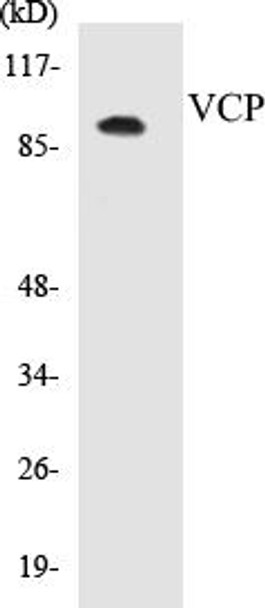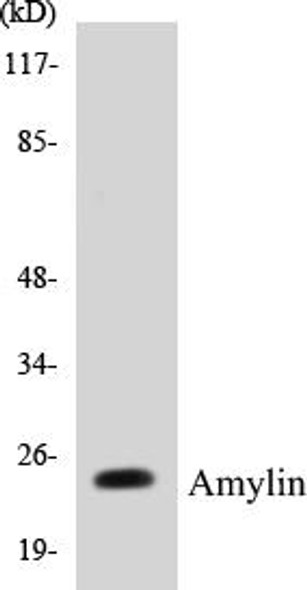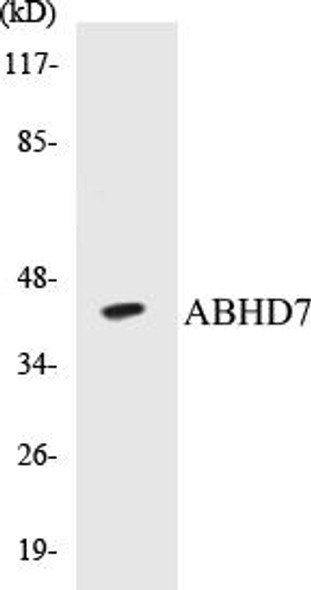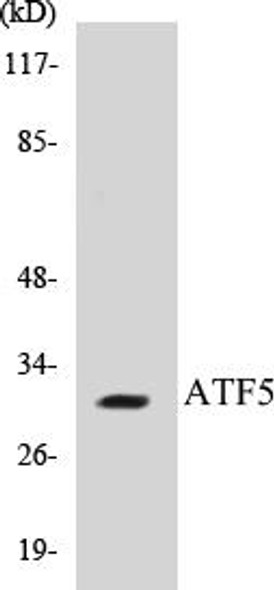Description
VCP Colorimetric Cell-Based ELISA Kit
The VCP Colorimetric Cell-based ELISA Kit is specifically designed for the sensitive and accurate detection of VCP (Valosin containing protein) levels in cell lysates and tissue samples. With its high sensitivity and specificity, this kit provides reliable and reproducible results, making it a valuable tool for researchers studying VCP-related pathways and diseases.VCP is a key protein involved in various cellular processes, including protein degradation, DNA repair, and cell cycle regulation. Dysregulation of VCP has been linked to a variety of diseases, such as neurodegenerative disorders, cancer, and autoimmune diseases.
By measuring VCP levels, researchers can gain insights into disease mechanisms and potential therapeutic targets.Overall, the VCP Colorimetric Cell-based ELISA Kit offers researchers a powerful tool to study VCP biology and its implications in health and disease. With its easy-to-use format and robust performance, this kit is suitable for a wide range of research applications.
| Product Name: | VCP Colorimetric Cell-Based ELISA |
| Product Code: | CBCAB00902 |
| ELISA Type: | Cell-Based |
| Target: | VCP |
| Reactivity: | Human, Mouse, Rat |
| Dynamic Range: | > 5000 Cells |
| Detection Method: | Colorimetric 450 nmStorage/Stability:4°C/6 Months |
| Format: | 96-Well Microplate |
The VCP Colorimetric Cell-Based ELISA Kit is a convenient, lysate-free, high throughput and sensitive assay kit that can detect VCP protein expression profile in cells. The kit can be used for measuring the relative amounts of VCP in cultured cells as well as screening for the effects that various treatments, inhibitors (ie siRNA or chemicals), or activators have on VCP.
Qualitative determination of VCP concentration is achieved by an indirect ELISA format. In essence, VCP is captured by VCP-specific primary antibodies while the HRP-conjugated secondary antibodies bind the Fc region of the primary antibody. Through this binding, the HRP enzyme conjugated to the secondary antibody can catalyze a colorimetric reaction upon substrate addition. Due to the qualitative nature of the Cell-Based ELISA, multiple normalization methods are needed:
| 1. | A monoclonal antibody specific for human GAPDH is included to serve as an internal positive control in normalizing the target absorbance values. |
| 2. | Following the colorimetric measurement of HRP activity via substrate addition, the Crystal Violet whole-cell staining method may be used to determine cell density. After staining, the results can be analysed by normalizing the absorbance values to cell amounts, by which the plating difference can be adjusted. |
| Database Information: | Gene ID: 7415, UniProt ID: P55072, OMIM: 167320/601023, Unigene: Hs.529782 |
| Gene Symbol: | VCP |
| Sub Type: | None |
| UniProt Protein Function: | VCP: valosin-containing protein (VCP) is a member of a family that includes putative ATP-binding proteins involved in vesicle transport and fusion, 26S proteasome function, and assembly of peroxisomes. VCP, as a structural protein, is associated with clathrin, and heat-shock protein Hsc70, to form a complex. Necessary for the fragmentation of Golgi stacks during mitosis and for their reassembly after mitosis. Involved in the formation of the nuclear envelope and of the transitional endoplasmic reticulum (tER). Regulates NFKappaB pathway, which is important for metastasis of osteosarcoma. Tyrosine phosphorylation regulates its cell cycle-dependent nuclear localization. |
| UniProt Protein Details: | Protein type:Endoplasmic reticulum; EC 3.6.4.6; DNA repair, damage; Chaperone; Hydrolase Chromosomal Location of Human Ortholog: 9p13.3 Cellular Component: nucleoplasm; proteasome complex; endoplasmic reticulum membrane; intracellular membrane-bound organelle; perinuclear region of cytoplasm; endoplasmic reticulum; cytoplasm; lipid particle; cytosol; nucleus Molecular Function:protein domain specific binding; identical protein binding; protein binding; ATPase activity; protein complex binding; ADP binding; polyubiquitin binding; protein phosphatase binding; lipid binding; ATP binding; receptor binding Biological Process: caspase activation; proteasomal ubiquitin-dependent protein catabolic process; ER to Golgi vesicle-mediated transport; ER-associated protein catabolic process; unfolded protein response; protein ubiquitination; DNA repair; regulation of apoptosis; retrograde protein transport, ER to cytosol; bypass DNA synthesis; establishment of protein localization; positive regulation of protein complex assembly; positive regulation of proteasomal ubiquitin-dependent protein catabolic process; double-strand break repair; positive regulation of protein catabolic process; protein amino acid N-linked glycosylation via asparagine; response to DNA damage stimulus; protein homooligomerization Disease: Amyotrophic Lateral Sclerosis 14, With Or Without Frontotemporal Dementia; Inclusion Body Myopathy With Early-onset Paget Disease With Or Without Frontotemporal Dementia 1 |
| NCBI Summary: | The protein encoded by this gene is a member of a family that includes putative ATP-binding proteins involved in vesicle transport and fusion, 26S proteasome function, and assembly of peroxisomes. This protein, as a structural protein, is associated with clathrin, and heat-shock protein Hsc70, to form a complex. It has been implicated in a number of cellular events that are regulated during mitosis, including homotypic membrane fusion, spindle pole body function, and ubiquitin-dependent protein degradation. [provided by RefSeq, Jul 2008] |
| UniProt Code: | P55072 |
| NCBI GenInfo Identifier: | 6094447 |
| NCBI Gene ID: | 7415 |
| NCBI Accession: | P55072.4 |
| UniProt Secondary Accession: | P55072,Q0V924, Q2TAI5, Q969G7, Q9UCD5, B2R5T8, |
| UniProt Related Accession: | P55072 |
| Molecular Weight: | 89,322 Da |
| NCBI Full Name: | Transitional endoplasmic reticulum ATPase |
| NCBI Synonym Full Names: | valosin containing protein |
| NCBI Official Symbol: | VCP |
| NCBI Official Synonym Symbols: | p97; TERA; ALS14; IBMPFD |
| NCBI Protein Information: | transitional endoplasmic reticulum ATPase; TER ATPase; yeast Cdc48p homolog; valosin-containing protein; 15S Mg(2+)-ATPase p97 subunit |
| UniProt Protein Name: | Transitional endoplasmic reticulum ATPase |
| UniProt Synonym Protein Names: | 15S Mg(2+)-ATPase p97 subunit; Valosin-containing protein |
| Protein Family: | Transitional endoplasmic reticulum ATPase |
| UniProt Gene Name: | VCP |
| UniProt Entry Name: | TERA_HUMAN |
| Component | Quantity |
| 96-Well Cell Culture Clear-Bottom Microplate | 2 plates |
| 10X TBS | 24 mL |
| Quenching Buffer | 24 mL |
| Blocking Buffer | 50 mL |
| 15X Wash Buffer | 50 mL |
| Primary Antibody Diluent | 12 mL |
| 100x Anti-Phospho Target Antibody | 60 µL |
| 100x Anti-Target Antibody | 60 µL |
| Anti-GAPDH Antibody | 60 µL |
| HRP-Conjugated Anti-Rabbit IgG Antibody | 12 mL |
| HRP-Conjugated Anti-Mouse IgG Antibody | 12 mL |
| SDS Solution | 12 mL |
| Stop Solution | 24 mL |
| Ready-to-Use Substrate | 12 mL |
| Crystal Violet Solution | 12 mL |
| Adhesive Plate Seals | 2 seals |
The following materials and/or equipment are NOT provided in this kit but are necessary to successfully conduct the experiment:
- Microplate reader able to measure absorbance at 450 nm and/or 595 nm for Crystal Violet Cell Staining (Optional)
- Micropipettes with capability of measuring volumes ranging from 1 µL to 1 ml
- 37% formaldehyde (Sigma Cat# F-8775) or formaldehyde from other sources
- Squirt bottle, manifold dispenser, multichannel pipette reservoir or automated microplate washer
- Graph paper or computer software capable of generating or displaying logarithmic functions
- Absorbent papers or vacuum aspirator
- Test tubes or microfuge tubes capable of storing ≥1 ml
- Poly-L-Lysine (Sigma Cat# P4832 for suspension cells)
- Orbital shaker (optional)
- Deionized or sterile water
*Note: Protocols are specific to each batch/lot. For the correct instructions please follow the protocol included in your kit.
| Step | Procedure |
| 1. | Seed 200 µL of 20,000 adherent cells in culture medium in each well of a 96-well plate. The plates included in the kit are sterile and treated for cell culture. For suspension cells and loosely attached cells, coat the plates with 100 µL of 10 µg/ml Poly-L-Lysine (not included) to each well of a 96-well plate for 30 minutes at 37°C prior to adding cells. |
| 2. | Incubate the cells for overnight at 37°C, 5% CO2. |
| 3. | Treat the cells as desired. |
| 4. | Remove the cell culture medium and rinse with 200 µL of 1x TBS, twice. |
| 5. | Fix the cells by incubating with 100 µL of Fixing Solution for 20 minutes at room temperature. The 4% formaldehyde is used for adherent cells and 8% formaldehyde is used for suspension cells and loosely attached cells. |
| 6. | Remove the Fixing Solution and wash the plate 3 times with 200 µL 1x Wash Buffer for five minutes each time with gentle shaking on the orbital shaker. The plate can be stored at 4°C for a week. |
| 7. | Add 100 µL of Quenching Buffer and incubate for 20 minutes at room temperature. |
| 8. | Wash the plate 3 times with 1x Wash Buffer for 5 minutes each time. |
| 9. | Add 200 µL of Blocking Buffer and incubate for 1 hour at room temperature. |
| 10. | Wash 3 times with 200 µL of 1x Wash Buffer for 5 minutes each time. |
| 11. | Add 50 µL of 1x primary antibodies (Anti-VCP Antibody and/or Anti-GAPDH Antibody) to the corresponding wells, cover with Parafilm and incubate for 16 hours (overnight) at 4°C. If the target expression is known to be high, incubate for 2 hours at room temperature. |
| 12. | Wash 3 times with 200 µL of 1x Wash Buffer for 5 minutes each time. |
| 13. | Add 50 µL of 1x secondary antibodies (HRP-Conjugated AntiRabbit IgG Antibody or HRP-Conjugated Anti-Mouse IgG Antibody) to corresponding wells and incubate for 1.5 hours at room temperature. |
| 14. | Wash 3 times with 200 µL of 1x Wash Buffer for 5 minutes each time. |
| 15. | Add 50 µL of Ready-to-Use Substrate to each well and incubate for 30 minutes at room temperature in the dark. |
| 16. | Add 50 µL of Stop Solution to each well and read OD at 450 nm immediately using the microplate reader. |
(Additional Crystal Violet staining may be performed if desired – details of this may be found in the kit technical manual.)






